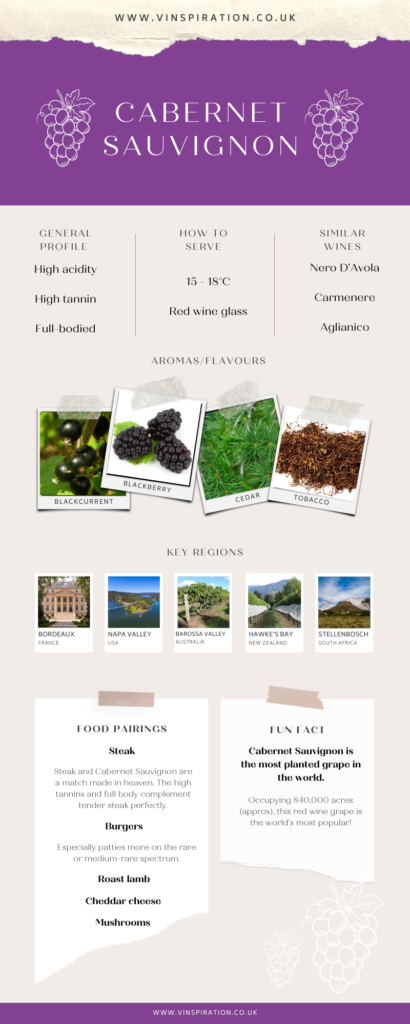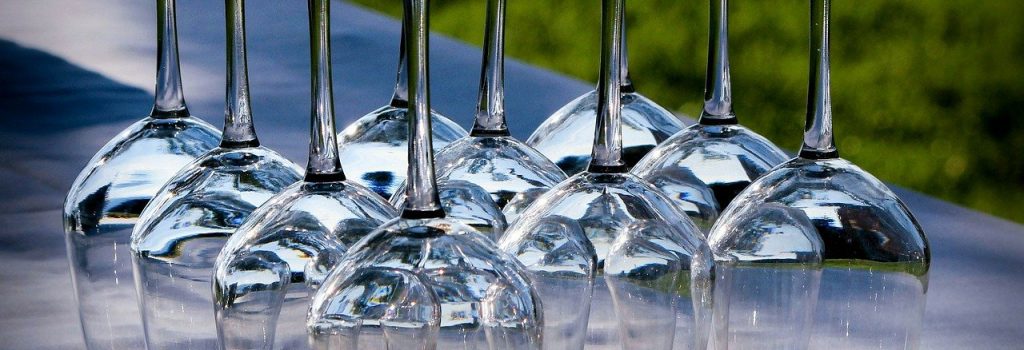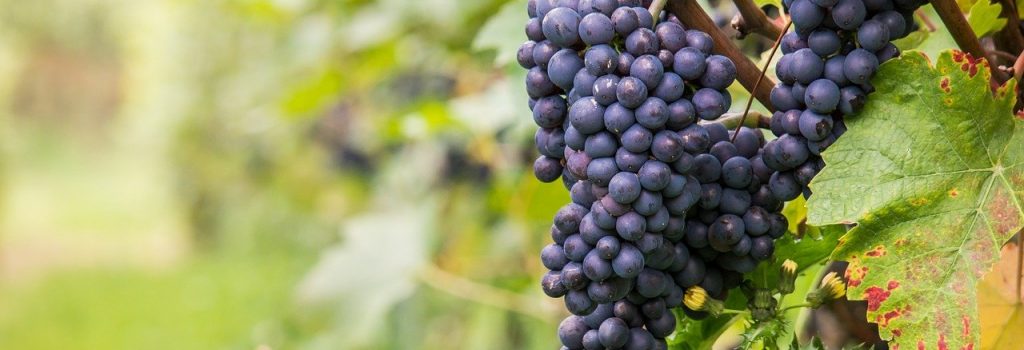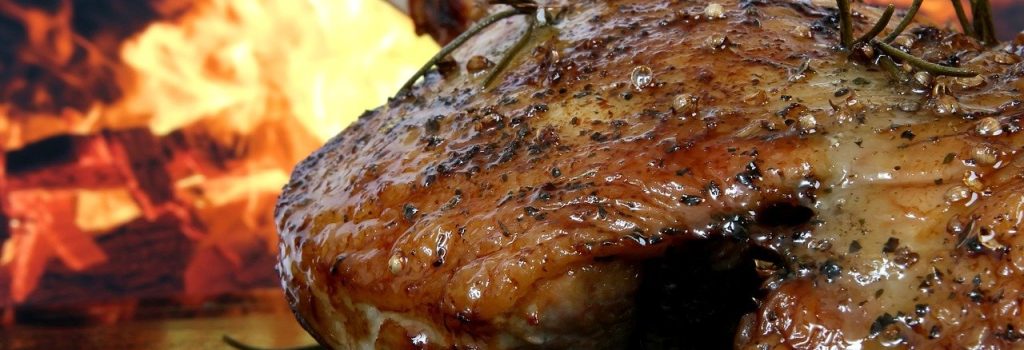
Cabernet Sauvignon; the powerful grape
“Age is just a number. It’s totally irrelevant unless, of course, you happen to be a bottle of wine.”
– Joan Collins
The basics
Cabernet Sauvignon is a black grape variety and is the most widely planted wine grape in the world. It is a relatively easy grape to grow, preferring moderate and warm climates overall. The grape has a notoriety for being highly tannic and extremely powerful; exhibiting black fruit flavours, such as cherry, plum and blackberry.
The expression of a Cabernet Sauvignon is a powerful one. In general, the wines produced can be highly tannic and acidic (perfect for long ageing) and exhibit an equally full body. Wines made from this grape (or the Bordeaux blend – more info below) are some of the most highly sought after wines in the world; demanding high price tags.

What's the difference between right and left bank in Bordeaux?
There are several differences between Bordeaux’ right and left bank, but the main ones are the dominant grape varieties in each Bordeaux blend. The left bank produces wines dominated by Cabernet Sauvignon, whereas the right bank makes wines with a Merlot dominant blend.
The left bank and the right bank are separated by the Gironde Estuary, which splits into two rivers (the Dordogne and Garonne). On the left bank of these rivers, and closer to the Atlantic ocean, is the region of the Médoc. Within the Médoc is the infamous sub-appellations of St-Estèphe, Pauillac, St-Julien and Margaux. As well as appellations of Pessac-Léognan and Graves. The left bank has gravel soil. Gravel soil allows for good drainage meaning the wines don’t get damp and cold, and that the stones reflect the sunlight to keep the grapes warm. All of these conditions are perfect for helping Cabernet Sauvignon ripen.
On the right bank, the soil is made up of clay and limestone. This means they are well suited for the production of Merlot. The right bank is made up of the famous appellations of Saint-Émilion and Pomerol.
In general, Merlot is the most widely planted grape in the Bordeaux region as a whole. Meaning, it generally is the dominant grape in most blends – other than the left bank. You will find the Merlot variety in the wider appellations of Bordeaux AOC and Bordeaux Supérieur AOC.

Which countries produce Cabernet Sauvignon?
Bordeaux, France
St-Estèphe AOC
Pauillac AOC
St Julien AOC
Marguax AOC
The left bank region of Bordeaux, France, is famed for Cabernet Sauvignon dominated blends. These wines are the softest and most acidic Cabernet Sauvignons of their kind, as the grape often struggles to ripen fully. These wines are highly tannic with black fruits and a green bell pepper (or capsicum) flavour.
California, USA
Napa Valley
Sonoma
Firstly, if you like rich chocolately wines, you will love this Californian power house. These wines are true power houses of flavour, with rich primary aromas like blackberry, black current and mint. As well as secondary flavours of vanilla, tobacco, smoke and chocolate. These wines are so enjoyable as they can be food wines (pair with a steak) or drunk alone.
Australia
Barossa Valley
Coonawarra
Australia’s Margaret River exports premium wines to all over the world, but it’s especially capitalised on its Bordeaux blends, made from a mix of Merlot and Cabernet Sauvignon (sometimes with Cabernet Franc too). As a result, these wines are high quality and the warmer climate usually always guarantees ripening.
New Zealand
Hawke's Bay
Hawke’s Bay prides itself on Cabernet Sauvignon that has concentrated cassis characteristics. The North Island of New Zealand generally allows for a warmer climate, allowing this grape to ripen fully. Be careful though, Cabernet Sauvignon from New Zealand packs a tannic punch.
South Africa
Stellenbosch
Paarl
Constantia
In the warmer climate of South Africa, Cabernet Sauvignon needs the moderating influence of a coastal region to develop balanced wines . Generally these wines will have firm tannins and a gorgeous mix of black fruit flavours (such as blackcurrent and blackberry).
Chile
Aconcagua Valley
Cachapoal Valley
The fertile valley floor of Aconcagua allows for Cabernet Sauvignon to mature – with high tannin, rich fruit and high alcohol content. Unlike the Cachapoal Valley to the east, whose cooling influences lead to firmer wines.

Food pairings for Cabernet Sauvignon
Cabernet Sauvignon is one of the most full-bodied and tannic wines in the world. Well known by wine lovers and novices alike, there are some absolutely classic pairings (such as steak) and some more nuanced accompaniments to this grape.
Steak
Never was there a most well-known and beloved pairing than Cabernet Sauvignon and steak. Truly, around the world, this full-bodied red wine is the true partner in crime of this tender meat. The slightly-burnt meaty char is masked immaculately by the rich, tannic red wine – allowing for an explosive tasting experience.
Pair with: Cabernet Sauvignon from Napa Valley or Sonoma County
Burgers
Cabernet Sauvignon and burgers go hand-in-hand; another perfect pairing. With a wealth of options, we recommend having a medium or medium-rare burger to really take advantage of the tannic and berry-forward duo.
Pair with: A Bordeaux blend from the left bank
Lamb
A tender and delicious leg of lamb or lamb steak (especially with lots of rosemary) pairs beautifully with a full-bodied and fruit-forward Cabernet Sauvignon. Again, the heavy meat matched by an equally heavy wine works wonders. Try pairing with wines with a South African or South American influence.
Pair with: Cabernet Sauvignon from Chile – preferably the Cachapoal Valley
